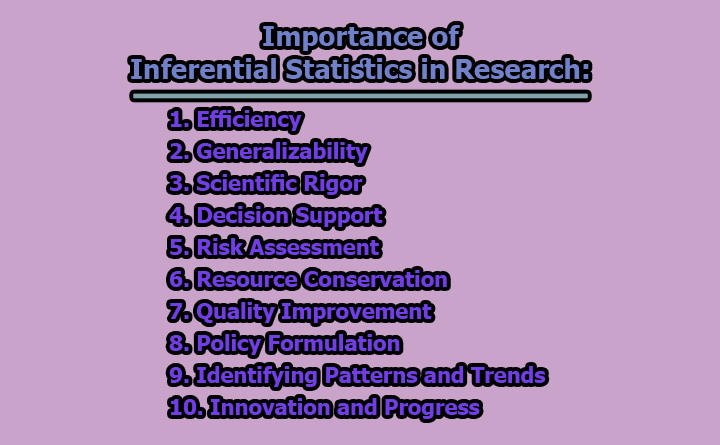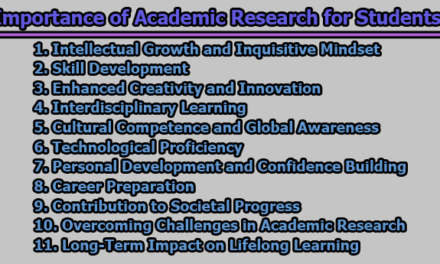Importance of Inferential Statistics in Research:
In the ever-evolving landscape of research, the quest for meaningful insights hinges on our ability to extract valuable information from data. This is where inferential statistics emerges as a beacon of enlightenment, guiding researchers through the intricate process of making sense of the world’s complexities. In this article, we will explore the importance of inferential statistics in research.
1. Efficiency (Navigating the Ocean of Data): In a world awash with data, the notion of studying an entire population is often daunting, if not impossible. Inferential statistics offer a lifeline to researchers seeking to efficiently glean knowledge from samples. By analyzing a representative subset, they can make predictions and draw conclusions about entire populations. Consider a pharmaceutical company testing a new drug. It is far more practical to study a sample of patients, making inferential statistics a powerful tool for efficiently evaluating the drug’s effectiveness for a larger patient population.
2. Generalizability (Bridging the Gap to Wider Relevance): Research findings are most valuable when they can be extended to larger contexts. Inferential statistics provide the bridge, enabling researchers to generalize their findings from samples to broader populations. Think of a sociologist studying the attitudes of a specific community towards social issues. Through inferential statistics, insights drawn from the sample can be relevant not only to the group studied but also to similar communities. This generalizability enhances the applicability and significance of research.
3. Scientific Rigor (A Shield of Credibility): In the scientific realm, rigor is paramount. Inferential statistics offer a rigorous framework for hypothesis testing and data analysis. By subjecting research findings to statistical tests, researchers can determine whether their results are statistically significant. This enhances the credibility of research outcomes. For instance, in medical research, inferential statistics rigorously test whether a new treatment outperforms an existing one, ensuring that medical advancements are built on solid scientific foundations.
4. Decision Support (Guiding Choices with Data): In the world of business and policy, decisions should ideally be data-driven. Inferential statistics equip decision-makers with valuable insights. Marketing strategists, for instance, use inferential statistics to assess the impact of different advertising campaigns on customer behavior. In the medical field, doctors use these statistics to make informed choices about treatment options for patients. By tapping into the world of data, decision-makers can chart their course with greater confidence and precision.
5. Risk Assessment (Navigating the Uncertain Terrain): The world is replete with uncertainties, and risk assessment is vital in many domains. Inferential statistics come to the rescue by quantifying and assessing risks. In finance, for example, investors rely on these statistics to predict market movements and manage investment portfolios. Insurance companies employ them to estimate the likelihood of events such as accidents or illnesses. In public health, inferential statistics aid in evaluating the potential impact of disease outbreaks or preventive measures. These statistics provide a compass for navigating the uncertain seas of risk.
6. Resource Conservation (Making the Most of Limited Resources): Efficiency in resource utilization is a common concern in research. Inferential statistics enable researchers to conserve precious resources, including time, money, and effort. Instead of studying an entire population, they work with manageable samples. For example, a climate scientist studying the effects of climate change on a global scale may use data from specific locations or regions. Inferential statistics allow them to draw meaningful conclusions without the impracticality of measuring every location, thus preserving valuable resources for further research.
7. Quality Improvement (Identifying Flaws for a Brighter Future): In the world of manufacturing and quality control, perfection is the goal. Inferential statistics are instrumental in this pursuit. By analyzing samples of products, manufacturers can detect defects and identify areas for improvement. A car manufacturer, for instance, might inspect a subset of cars for safety and performance standards. If the sample meets the criteria, they can confidently assert that the entire production line maintains the same level of quality. This not only saves resources but also ensures that consumers receive high-quality products.
8. Policy Formulation (Shaping Society with Evidence): Public policy decisions have far-reaching consequences. Policymakers must base their choices on solid evidence. Inferential statistics provide the evidence they need to develop effective policies. Environmental policies, for instance, often require analyzing data from specific locations to assess the impact of regulations. By using inferential statistics, policymakers can craft policies grounded in empirical research, which are more likely to achieve desired outcomes while considering economic and social implications.
9. Identifying Patterns and Trends (Illuminating the Data Tapestry): Data can be like a puzzle with missing pieces, but inferential statistics help complete the picture. They reveal hidden patterns and trends that might not be apparent through basic descriptive statistics. Consider a data scientist analyzing customer behavior in an e-commerce platform. Inferential statistics can unveil subtle trends in buying habits or preferences, aiding in the formulation of targeted marketing strategies and product recommendations.
10. Innovation and Progress (Forging the Path Forward): Inferential statistics serve as the driving force behind innovation and progress. By enabling researchers to make accurate predictions, test hypotheses, and draw valid conclusions, they push the boundaries of knowledge and contribute to advancements in science, technology, and various research fields. These statistics are the bedrock upon which discoveries, breakthroughs, and improvements are built, shaping the future and driving positive change.
In conclusion, inferential statistics are not merely a set of mathematical tools; they are the linchpin that connects research, decision-making, and policy development across the vast spectrum of human endeavors. Their significance lies in their ability to streamline research, enhance generalizability, infuse rigor into science, guide decisions, manage risks, conserve resources, improve quality, drive policy formulation, reveal hidden insights, and propel innovation. The role of inferential statistics is not confined to laboratories or research institutions; it reverberates through boardrooms, clinics, factories, and government offices. In essence, inferential statistics are the foundation upon which informed choices, improved products, and a better society are built.

Library Lecturer at Nurul Amin Degree College










